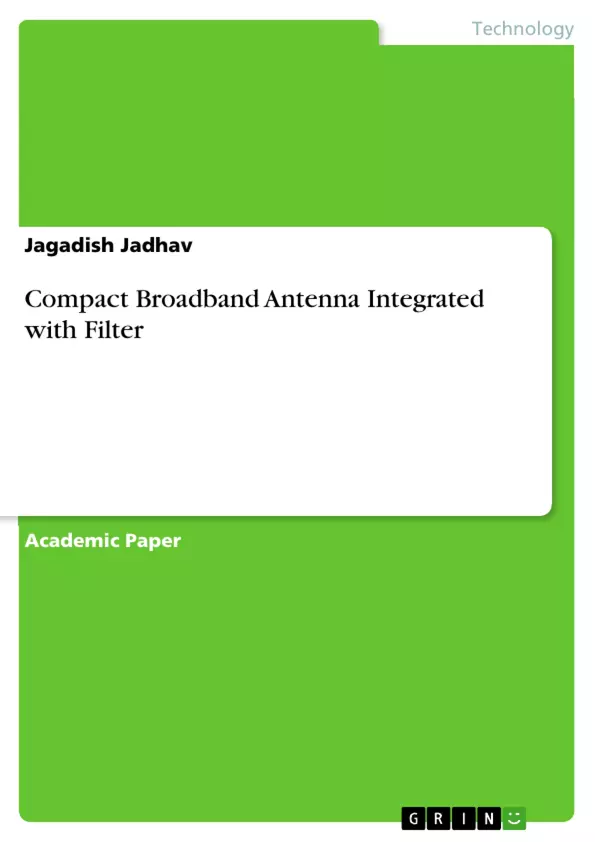In recent years, there has been constant growth in using gigahertz frequencies for various applications. The state of the art of antenna integration with passive circuits techniques offering increased cut-off frequencies, open up new opportunities for integrating systems along with an antenna for either Transmit/Receive application. The work carried out in this seminar mainly deals with the survey of antenna structures which are compatible to integrate with passive circuits for microwave as well as millimeter/sub-millimeter wave applications.
Lot of research in the field of passive receiver front end design is being carried out. This work covers three aspects of passive receiver front end design. The first is the analysis and design of new wide band high gain micro strip antennas, the second aspect is the design of compact high performance low-pass and band-pass filters and the third aspects is to integrate antenna and filter into single substrate. The trend of communication systems has imposed many restrictions on designers to have systems which should be light weight, robustness and have easy integration to other microwave circuits.
In most of the communications systems the receiving antenna is followed with a band-pass filter. In microwave band this is normally a distributed lter and is implemented using the transmission line resonators. The transmission line filters are not compact, and in many applications where size is an issue may not provide the best solution. In the new active arrays, for example, it is desirable to integrate a complete front end with each individual antenna element. The area allocated to each cell, however, is determined by the array design and apertures efficiency requirements and is barely integrate the antenna and band pass filter in a single module, as is it more compact may also decrease the prefiltering losses to improve the noise performance. The design of such system is a challenging task.
Inhaltsverzeichnis (Table of Contents)
- Abstract
- List of Figures
- List of Tables
- Abbreviations
- 1 Introduction
- 1.1 Antenna for Wireless Application
- 1.2 Filters for Wireless Application
- 1.3 Design Consideration Parameters of MSA
- 1.3.1 Substrate Properties
- 1.3.2 Resonant Element Length
- 1.3.3 Resonant Input Resistance
- 1.3.4 Bandwidth
- 1.3.5 Losses due to Surface Waves
- 1.3.6 Losses due to Dielectric
- 1.3.7 Losses due to Dispersion
- 1.4 Parameters of MSA.
- 1.4.1 Effect of Width (W)
- 1.4.2 Effect of Dielectric Constant
- 1.4.3 Effect of Height (h)
- 1.4.4 Effect of Loss Tangent
- 1.4.5 Effect of Probe Diameter
- 1.4.6 Effect of Feed Point Location (x)
- 1.4.7 Effect of Radome.
- 1.4.8 Effect of Ground Plane
- 1.5 Introduction to the Problem.
- 2 Related Literature Review
- 3 Parametric Study of MSA
- 3.1 Design Consideration Parameters of MSA
- 3.1.1 Substrate Properties
- 3.1.2 Resonant Element Length
- 3.1.3 Resonant Input Resistance
- 3.1.4 Bandwidth
- 3.1.5 Losses due to Surface Waves
- 3.1.6 Losses due to Dielectric
- 3.1.7 Losses due to Dispersion.
- 3.2 Parameters of MSA.
- 3.2.1 Effect of Width (W)
- 3.2.2 Effect of Dielectric Constant
- 3.2.3 Effect of Height (h)
- 3.2.4 Effect of Loss Tangent
- 3.2.5 Effect of Probe Diameter
- 3.2.6 Effect of Feed Point Location (x)
- 3.2.7 Effect of Radome .
- 3.2.8 Effect of Ground Plane
- 3.1 Design Consideration Parameters of MSA
- 4 Remarks and Conclusions
- 4.1 Remarks .
- 4.2 Conclusions
- Bibliography
Zielsetzung und Themenschwerpunkte (Objectives and Key Themes)
This seminar focuses on the design and integration of compact broadband antennas with passive filters, particularly for use in microwave and millimeter/sub-millimeter wave applications. The work aims to address the challenges of designing compact, robust, and easily integrated systems for wireless communication, while minimizing pre-filtering losses and improving noise performance.
- Design and analysis of wideband high gain microstrip antennas
- Design of compact high performance low-pass and band-pass filters
- Integration of antennas and filters onto a single substrate
- Parametric study of microstrip antenna (MSA) characteristics
- Exploration of design considerations for compact, high-performance systems in wireless communication
Zusammenfassung der Kapitel (Chapter Summaries)
Chapter 1 provides an overview of the research area, outlining the importance of compact broadband antennas and filters for wireless communication. It also introduces the key design parameters for microstrip antennas and discusses various design considerations for achieving optimal performance.
Chapter 2 delves into the related literature review, exploring existing research and approaches in the field of integrated antenna and filter design. This chapter provides a foundation for the research presented in the subsequent chapters.
Chapter 3 focuses on a parametric study of microstrip antennas, analyzing the effects of various design parameters, such as substrate properties, resonant element length, bandwidth, and losses. This chapter provides a deeper understanding of how different design choices impact antenna performance.
Schlüsselwörter (Keywords)
Compact broadband antennas, microstrip antennas, passive circuits integration, microwave filters, millimeter/sub-millimeter wave applications, wireless communication, antenna design, parametric study, noise performance.
- Quote paper
- Jagadish Jadhav (Author), 2019, Compact Broadband Antenna Integrated with Filter, Munich, GRIN Verlag, https://www.grin.com/document/462115



